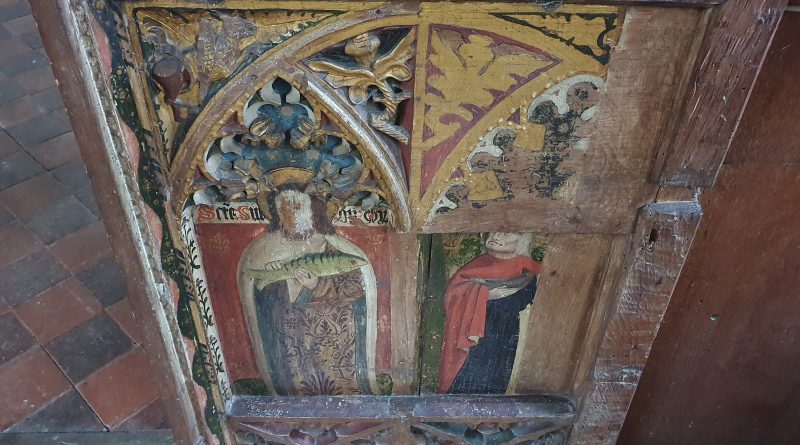Fritton – St. Catherine’s Church
I never knew about this church in Fritton, and indeed, nor did I even know that there are two Frittons in Norfolk. I’m a little surprised that one of the Frittons wasn’t renamed East, West, Great or something to avoid confusion. What I did discover here, and I might mention this again later, is that I’ve decided this is one of my favourite churches, it is absolutely beautiful.
The lych gate, with ‘lych’ being the Saxon word for a corpse, as this is where coffins are placed during part of the funeral service.
The church is reached down a small lane, or loke, and the churchyard looked all rather welcoming with daffodils.
There’s a round tower with the bottom two thirds likely being early Norman and the top third is a medieval repair or reconstruction.
This is the now blocked Norman doorway on the north side of the church.
The chancel end of the church has had something of a Victorian repair, and some work appears to have previously gone on to increase the height.
I’m not sure that I entirely understand what has happened here in terms of when the church was repaired and restored. A closer inspection shows that there is a brick frontage of much of the nave’s exterior, but that isn’t how it would have been built. It seems that there was a substantial repair during the seventeenth century (some sources say the eighteenth century), which is an unusual time for churches to be restored, giving it quite a unique appearance. The scale of the repair can’t be underestimated though, it seems that they thoroughly rebuilt the walls, but the inner section remained intact as the survival of earlier wall paintings testifies.
There’s a drawing at Picture Norfolk, and there is quite an effort to maintain copyright here which is unusual for an older print, so I’ll just link to it, but it shows the church in the mid-nineteenth century.
Entrance to the church is now through the early medieval porch on the south side of the church, with the holy stoup visible on the right of this photo.
Graffiti, which is probably medieval (but might be from last year for all I know) on the south door.
The door is fourteenth century and the initials of church wardens have been placed onto the metal strut.
The beautiful tiles, which I assume are Victorian or older.
A guidebook in the church mentioned that this recess in the north wall would have marked the site of an Easter Sepulchre which is where the Consecrated Host would be “buried” between Good Friday and Easter Day. This is a relatively simply version and there’s some evidence of wall painting near to it.
A consecration cross.
Looking down the church from the tower end. George Plunkett took a photo here in 1939, but not much has changed in the last 500 years, so there’s little difference since he was here eighty years ago.
There’s an area where some of the wooden panelling has been taken off the wall, revealing something of a damp problem. The church has only recently had electricity installed and before relied on Calor Gas, which has apparently caused some of these issues.
The ladder to the church tower. There are three bells in the belfry and they all date to the sixteenth century.
The font is from the fifteenth century and has smiling lions. That’s quite a jolly little set-up.
There’s no shortage of wall paintings in this church, these two were discovered later than the others.
This panelling on the screen is from the early sixteenth century and although some of the faces have been vandalised either during the Reformation or during the Civil War, it’s still in excellent condition.
More images of the screen.
The rood screen, which was added in 1913.
Looking back down the nave from underneath the screen.
The chancel.
The rood stairs are still in place, but have often been filled in to some degree at many churches.
All still intact.
This depicts St. Christopher and was funded by John Alward and his wife in the early sixteenth century.
I rarely know what wall paintings are supposed to represent as they’re so faded having been covered in whitewash. This takes little initiative to identify as George and the Dragon, a reminder of when churches were bright places to be with lots of colour on the wall.
The walls of this church are quite thick, and it seems that every space had some form of wall painting on it. I did think about the man (and I assume it was a man) who painted this several hundred years ago, wondering whether he considered how long it would survive for.
My final thoughts is that this church is magical with its fine wall paintings, its heritage and it had a warm atmosphere. Sometimes the Church of England don’t perhaps do enough to open up their churches to the communities that they serve, but the local vicar and parish seems to have fully engaged with the wider community. Definitely one of my favourite Norfolk churches.


































